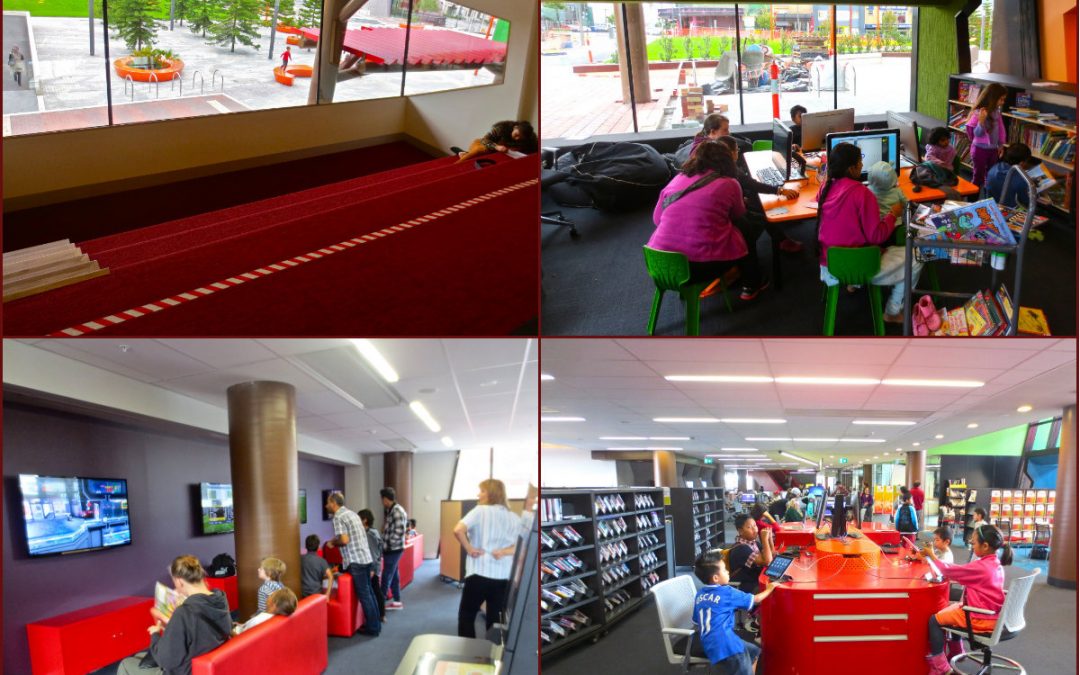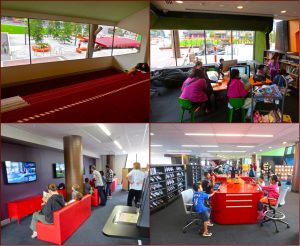City of Greater Dandenong ensures outstanding engagement with children. They are committed to Child Friendly Cities and Communities Charter, hold an annual forum with children, and a Children’s Advisory Group makes sure engagement with children is age and culture relevant.
I met Caroline Meier on site to learn more about Council’s recent Children’s Forum which investigated:
- children’s views of the library
- the public space of Harmony Square and City of Greater Dandenong parks and playgrounds
- activities, workshops and events offered to the children at various locations (including Heritage Hill, Drum theatre, Libraries, events and festivals)
The site
Harmony Square is an outdoor space at the heart of the City of Greater Dandenong civic precinct. The large library’s floor to ceiling glass windows at ground floor forms the margin between the world of the square and the looking, learning and settling in space of the library.
I walked on to the square seeing a sunny open space well supplied with colourful seating. Oh great! a big screen like Fed Square. A quite formal planting of Norfolk Pine and some more free formed trees. A coffee shop with a servery facing out on to its grouped seats.
Children apparently like the coffee shop being there so their parents have something to do when they’re at the library. Council has also learned about what children don’t like so much about the Square through input from the Forum. Activities also took place in the library and other locations. Prior to the Forum Caroline had worked extensively within council in the lead up phase, and liaised with schools. She’s now busy getting the kids’ views back to council departments.
Children’s Forum: views on the library
Caroline and I sat in the library near the cafe. ‘The library staff designed their part of the children’s engagement,’ she said.
What she had to say next make me pause and reflect on deliberative forums. That is, participants have to become knowledgeable on what it is they are making recommendations about. To do this, there was a treasure hunt roving over two levels as the starting activity. Kids had to find certain kinds of chairs and various sections in the collection, such as the location of the children’s non-fiction.
Only once they had this level of familiarity did the activities begin. A children’s author got them to design the cover of a book and give it a title. This generated great insight into what kind of books they would like to see in the collection. The fact that the author had written bilingual children’s stories validated cohort’s diverse cultural backgrounds. It really gave them permission to express a desire for books reflecting their culture.
There was a survey on iPads. The kids said they’d like it to be a space where children’s art is displayed. What about a message tree? suggested one child, so that children could leave messages there and read messages from others.
‘A community intent,’ Caroline reflected.
Engagement with Children: an Advisory Group
One of the strongest elements of community intent in Caroline’s own work is a Children’s Advisory Group comprised of a small group of children representative of the local primary schools. They meet regularly to contribute to the planning of the Children’s Forum, design surveys and give feedback on ideas. The Children’s Forum is age and culture relevant because of their critical eye of the process. This reminds me of how important advisory and reference groups are to the success of citizens’ juries.
Next: Children’s views on Harmony Square


